MIO - Compression plating
1. Principles
Indications
MIO Compression plating should be used for only select intact segmental fractures. It is best suited for:
- fractures with a single intermediate segment:
- minimally displaced fractures with an intermediate segment with one or more wedge fragments.
Experience in minimally invasive techniques is necessary. If the operating surgeon is inexperienced, open reduction should be considered.
We illustrate one solution, but the treating surgeon must select the most appropriate approach, based on the myriad of relevant factors, including fracture features, available resources, and surgeons experience.
General considerations
Tibial shaft fractures near the knee or ankle may require plate fixation, instead of IM nails. MIO techniques are advantageous because they preserve the biology at the fracture site. By limiting skin incisions and surgical dissection, using indirect reduction techniques and basic plating concepts, adequate fixation and alignment can be obtained without additional damage to the fracture area.
With minimally invasive plating technique, each fracture line is dealt with separately in a stepwise manner. If there is comminution, a fracture site will require a bridging technique. However, simple short oblique or transverse fractures should be fixed with interfragmentary compression, to obtain absolute stability.
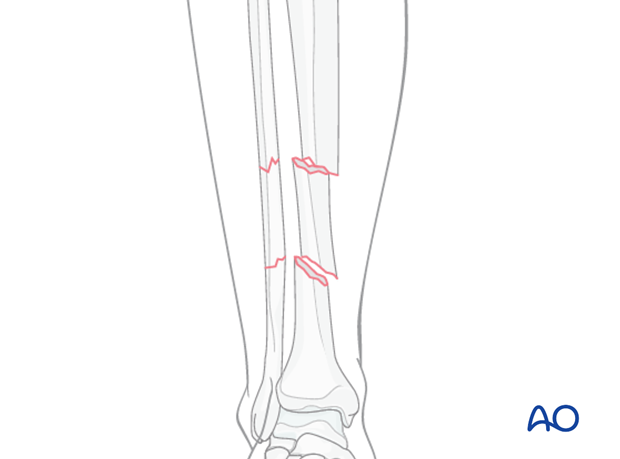
Preoperative planning
With MIO techniques, preoperative planning is of utmost importance and should include all steps of the procedure (including appropriate approach, reduction techniques, instruments, and implants). Anatomically shaped plates are helpful but not necessary for this technique. Plate bending devices may be used to shape a straight plate to fit the bony surface.
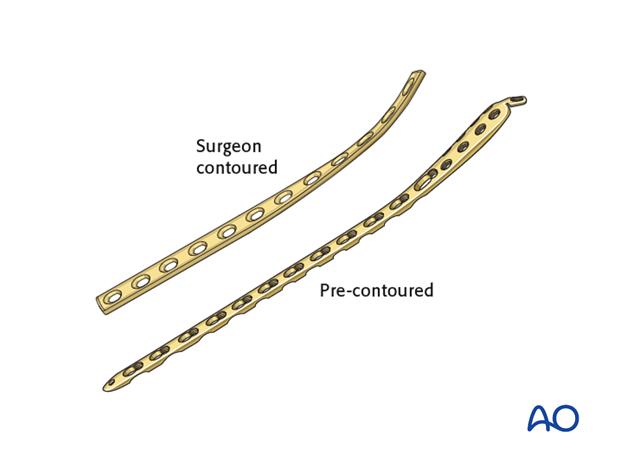
Intraoperative imaging
With limited windows through the skin and no direct visualization of the fragments, image intensifiers become a key surgical tool in MIPO. The view should be adequate to get as large a picture as possible for the assessment of axial alignment. The position of the C-arm is critical in order to achieve orthogonal views during surgery, and should be tested before surgery.
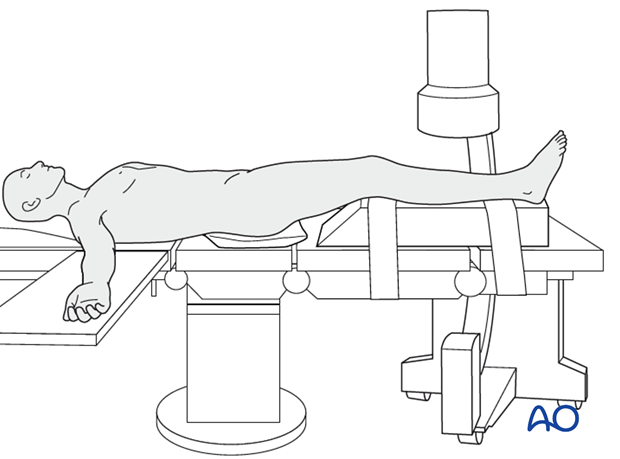
2. Patient preparation and approaches
Patient preparation
The patient is in a supine position on a radiolucent table or a standard operating table with a radiolucent extension. A pad is placed underneath the buttock to prevent external rotation.
A large foam bolster or cushion is placed under the affected leg to raise it above the opposite leg and facilitate lateral C-arm images.
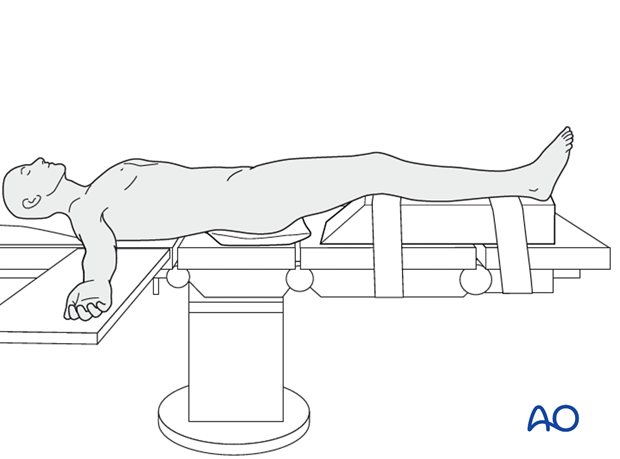
Approaches
If the soft tissues allow, the medial approach is preferred because it is easier to pass the screws percutaneously with less soft-tissue interference.
The lateral approach should be chosen if the medial soft tissues are significantly injured.
In certain fracture patterns a combination of open and closed techniques may be necessary. Conversion to an open method is sometimes required when closed methods do not achieve a sufficient reduction.
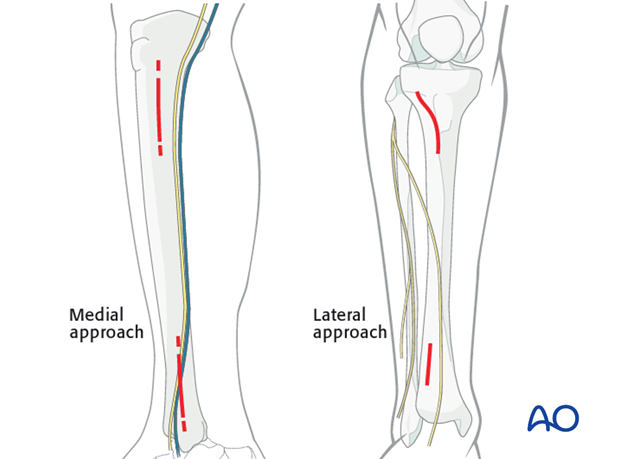
3. Reduction
Reduction principle
The key to all fracture reduction is restoring axial length.
Ways of gaining length are:
- Manual traction (for simpler fresh fractures)
- Distractor/external fixator
- Articulated tension device (ATD)
- Push-pull screws
- Use of reduction forceps
Large distractor or external fixator
Use a large distractor for closed reduction. Place a Schanz pin in both proximal and distal fragments. Distraction is applied across these pins by turning the nut on the threaded rod.
It may be necessary to place a Schanz pin in the intermediate fragment as a joystick to allow manipulation of the intermediate fragment. Generally it is easiest to reduce the least displaced of the two fractures and stabilize that component of the fracture.
If the plate is to be placed medially, then the distractor should be placed anteriorly.
Note: The pins must be placed in the same anatomical plane, so that when the distractor is attached, rotational alignment of the tibia is correct. With the distractor in place, rotational alignment is hard to change.

Pitfall
With significant tension of the distractor, the fracture may angulate, with concavity on the side opposite to the distractor.
If the distractor is medial, it can produce valgus. If it is anterior, it can cause flexion (apex-anterior angulation) at the fracture, as shown here.
If the surgeon recognizes this problem, it can be corrected by adjusting the distractor pin clamps to favor the opposite deformity.
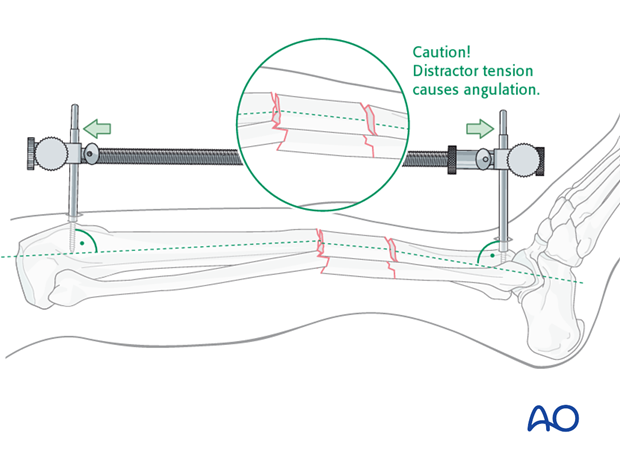
Solution
The distractor or external fixator pins can be adjusted to correct the angular deformity. When the distractor is lengthened, tension is asymetrically applied to the soft tissues, so that angulation is produced at the fracture. The side opposite the distractor becomes concave.
As shown here, the distractor pin-clamps have been angulated to produce apex-posterior angulation. As tension is applied, length is restored, and the apex-posterior deformity is corrected.
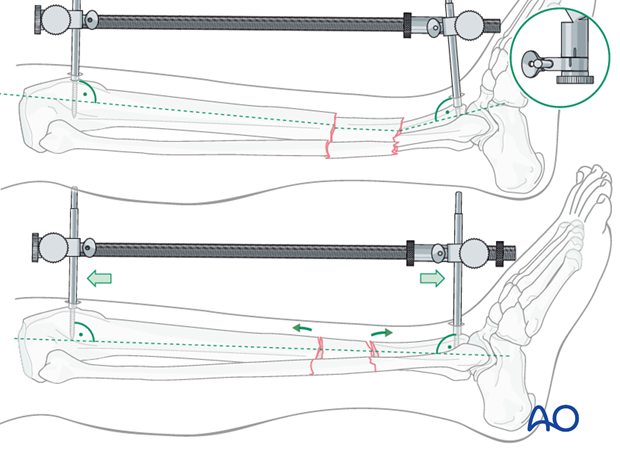
Alternative: Articulated tension device (ATD)
To use the ATD, in distraction mode, a precontoured plate is applied to one of the main fracture fragments. The distracting forces are then applied with the ATD against the opposite end of the plate.
With a segmental fracture, and the goal of compression plating, it is necessary to reduce one fracture anatomically, and stabilize it, and then repeat this for the second fracture.
The first step is to distract both fracture planes, as shown in the illustration.
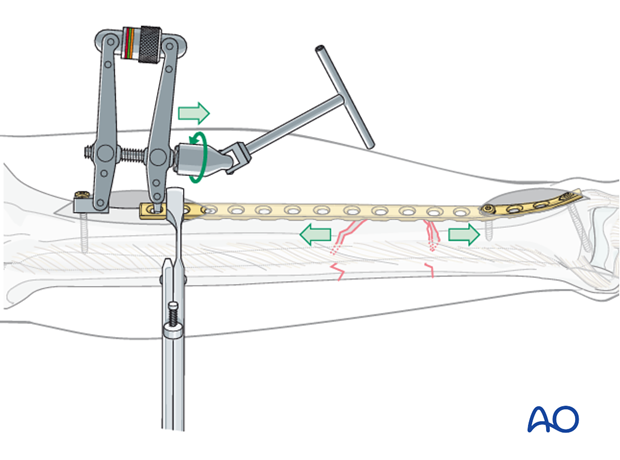
In this illustration, the proximal, short oblique fracture has been anatomically reduced and provisionally fixed with percutaneous pointed reduction forceps.

With the proximal fracture provisionally fixed with the pointed reduction forceps, the transverse fracture may be reduced and compressed using the ATD.

Alternative: Push-pull screw
A precontoured plate is applied to one of the main fragments. A bicortical screw is then placed near the end of the plate and the laminar spreader is used to apply distraction force through the plate.
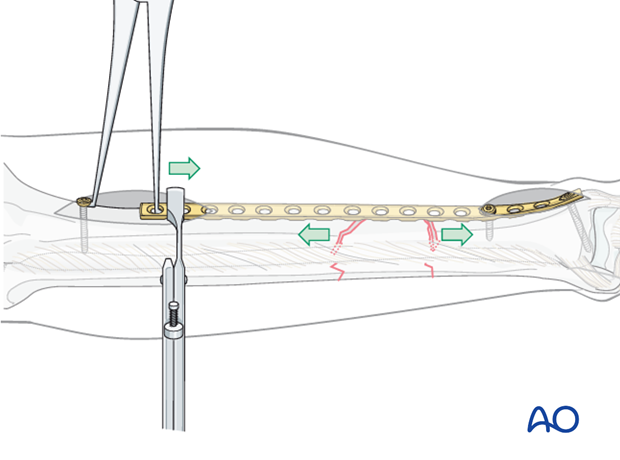
Then, with the length restored, the short oblique fracture can be reduced anatomically with the pointed reduction forceps.
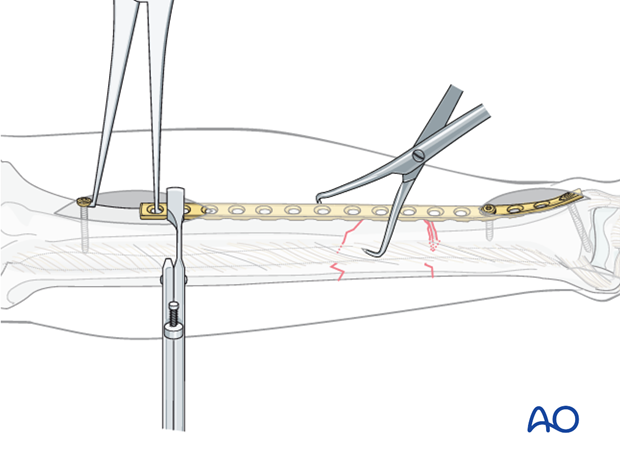
Now, with the proximal fracture clamped, the transverse fracture may be reduced and compressed using a Verbrugge clamp between the plate and the screw.

Pointed reduction forceps
Final reduction may be possible with percutaneously applied pointed reduction forceps. However, the presence of a free shaft segment may prevent successful reduction. Another clamp or joystick may be helpful.
Placement of the reduction forceps is key. Each point must be placed in anticipation of where it will be with the fracture reduced once length is restored. As illustrated, the forceps should be applied with the tines perpendicular to the fracture plane.
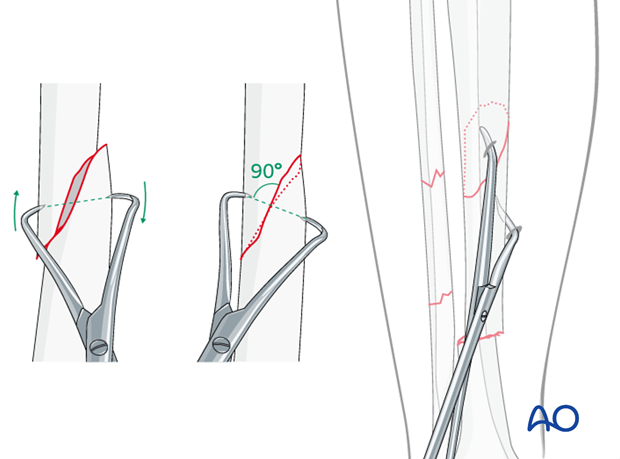
Pointed reduction forceps may also be used to grasp and manipulate fracture fragments as shown here. However, with transverse or short oblique fractures, these clamps are not effective for compressing the fracture surfaces.
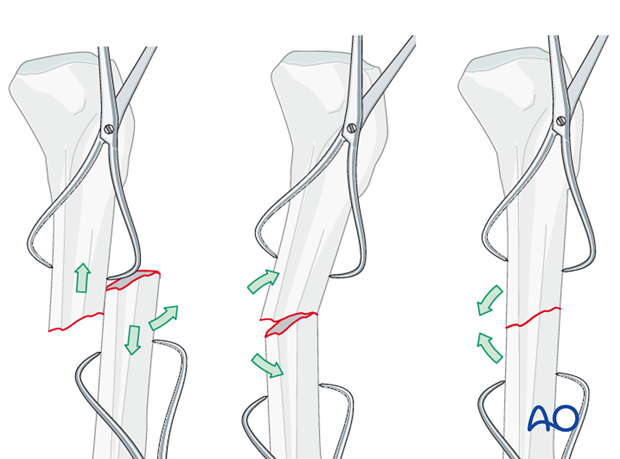
Pitfall: Malreduction of first fracture
Whichever fracture is fixed first, it must be reduced accurately, or the second fracture will not reduce satisfactorily.
Rotational alignment must be considered during application of any of the previous reduction methods.
Errors in rotation are the most common cause of malreduction using MIO techniques.
4. Plate selection and preparation
Choice of the plate
Plate length is based upon symmetry above and below the fracture zone. For most intact segmental fractures, the fracture zone includes both fracture sites. At least 3-4 screw holes on either side of the fracture zone are necessary. Another guideline, when fracture location permits, is that the plate should be roughly three times the length of the fracture zone.
Many intact segmental fractures can be fixed with standard plates after appropriate contouring.
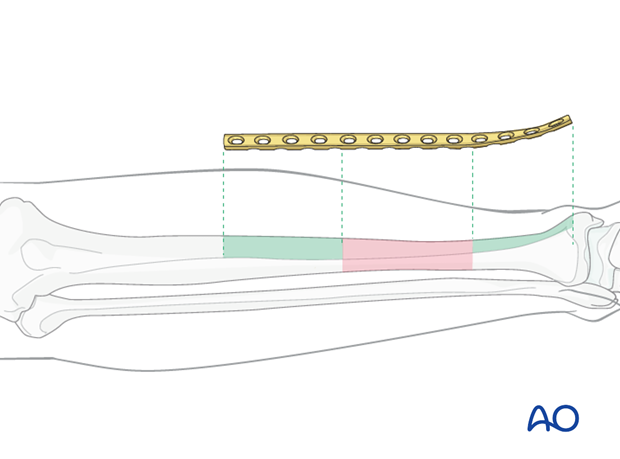
When the fracture zone is very distal or proximal, there may not be room enough for symmetric plate length in the segment nearest the articular surface. In this situation, a plate with multiple hole options in the metaphysis is chosen to improve fixation in the short periarticular segment.
A locking plate may be indicated if the bone quality is poor or when the fracture extends into softer metaphyseal bone.
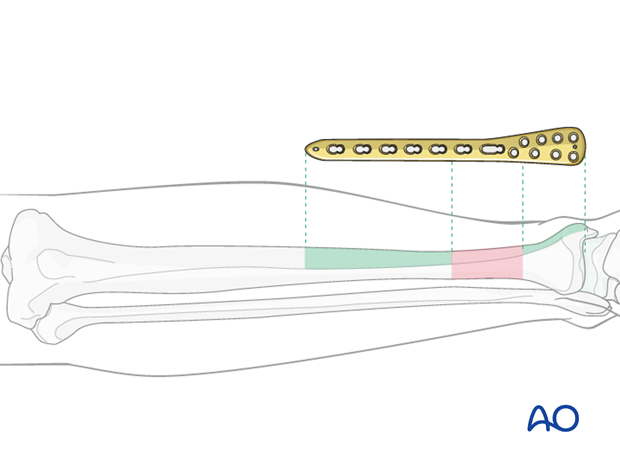
Traditionally a 4.5 mm plate has been advised for the tibial shaft. Its advantages include increased plate thickness and larger screw size for added strength. These plates are, however, more difficult to contour and may be too prominent.
A 3.5 mm plate offers improved contourability and multiple screw options in metaphyseal (end-segment) zones. However, they are less durable than the large fragment plates.
Another consideration is the choice between an anatomically precontoured plate or one which the surgeon contours. For plates which need to be contoured, the following steps have to be employed.

Twisting the plate
The anteromedial surface of the tibial shaft twists internally approximately 20° as it approaches the medial malleolus.
The first step of plate contouring is to twist the plate so it matches the tibial surface upon which it will lie.
If the plate is bent before it is twisted, the process of twisting will alter the bend that has been created.
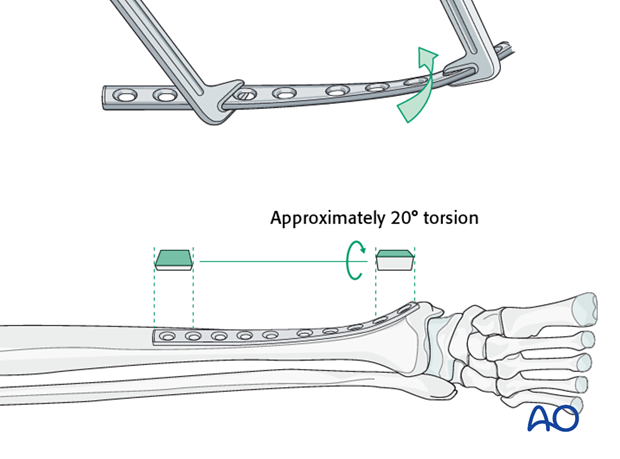
Matching the curvature
Depending upon the plate location, more or less bending of the plate will be required to match the contour of the intact (or reduced) bone. Much of the medial tibial shaft is quite straight, so that little bending is required. However, the distal medial surface has a significant concavity, with a typical radius of curvature of 20 cm as illustrated.
Such a 20 cm radius can be drawn on a sterile drape and used as a template for plates to be used in this location.
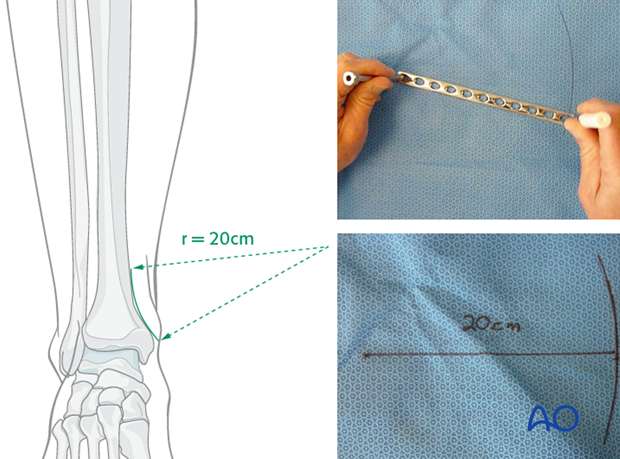
Bending the plate
The plate can be bent with bending irons alone, but it is preferable to bend with a bending press, because the press gives more control.
In either case, the bending is done in small steps to produce a smooth contour. Contouring only takes place over the distal 10-12 cm of the plate. When finished, the plate should match the 20 cm radius of curvature.

5. Fixation
If an oblique fracture is long enough, a percutaneous lag screw can be used to compress the final reduction. This can be done outside of the plate, or in some cases through the plate.
Note that in this example, the proximal fracture has been reduced anatomically and fixed with a lag screw. The distal fracture will now be reduced and fixed with the plate in compression mode. This plate also neutralizes the proximal fracture, to protect the lag screw.
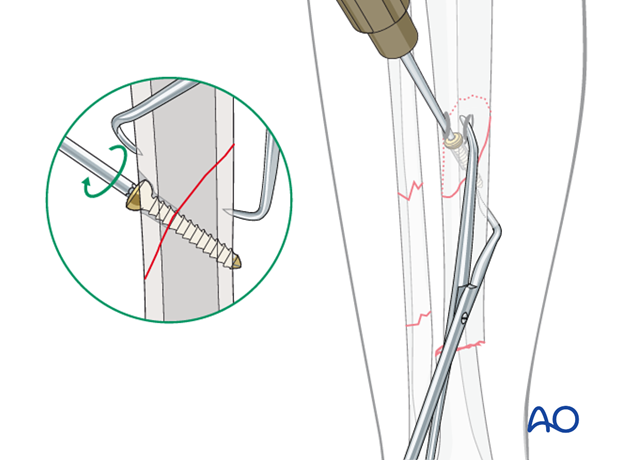
Plate insertion
An incision is made over the distal tibia and the plate is slid under the subcutaneous tissues.
If a locking plate or an anatomically contoured plate is used, the specifically designed end of the plate will facilitate this passage. In a conventional LCDC plate, it may be necessary to use a periosteal elevator to create a subcutaneous tunnel. If available, the subcutaneous tunneling device could be used.
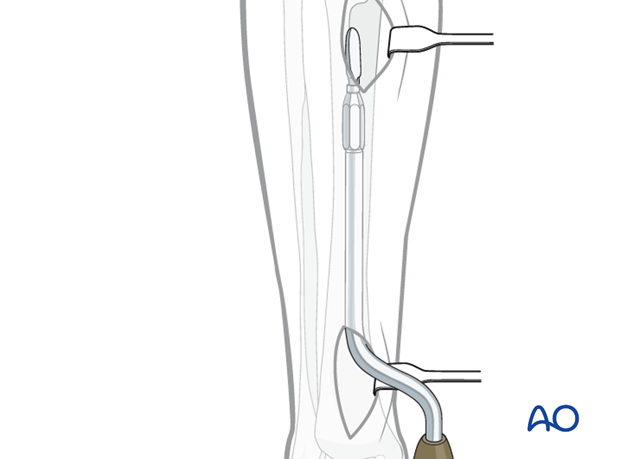
Position of the plate is adjusted on both the AP and lateral views. At this point, the plate can be provisionally held with K-wires.
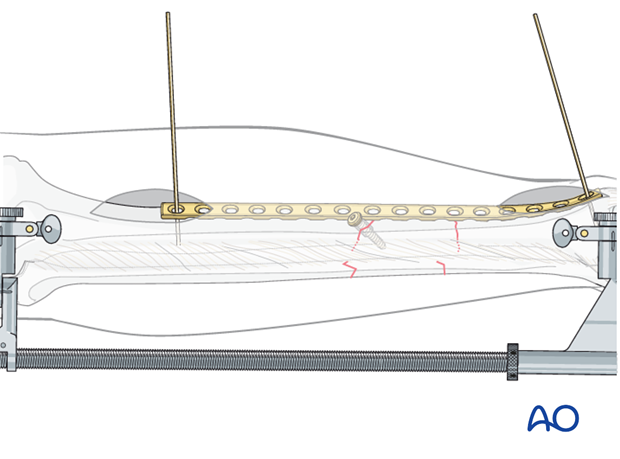
Initial screw placement
Through an image-directed stab wound, place the first screw according to antiglide principles (closing any gap between bone and plate to resist axial displacement) to improve axial alignment.
Reduction will only result if correct length has been achieved first. Check both AP and lateral views.
The initial screw must engage both cortices before it effects the reduction to ensure enough holding power to move the bone to the plate. This may mean that the first screw may be too long once the reduction has been accomplished. It can be exchanged later, after additional screws are placed.

Compression screw
Fracture compression is applied after reduction. This may be done with the articulated tension device or a push-pull screw and Verbrugge clamp.
Additional compression can be applied to a well-reduced fracture using a screw in the opposite main bone fragment. This is placed eccentrically in a self-compressing (DC) plate hole with an appropriate guide.

Pearl: Percutaneous screw insertion
Screws can be inserted into both ends of the plate through the small incisions made to insert the plate. The position of the screw holes in the central portion of the plate can be located by placing a plate of similar length on the skin over the inserted plate. The position of the screw holes can then be marked on the skin. Special drill sleeves are available for safe percutaneous insertion of screws into conventional plates.
Alternatively, lateral fluoroscopic imaging can assist the surgeon with plate hole location.

Interfragmentary lag screw
For sufficiently oblique fractures, absolute stability is best achieved by compressing the fracture plane with an interfragmentary lag screw placed perpendicular to the fracture.
Transverse fractures must rely upon tension-loading of an appropriately contoured compression plate.
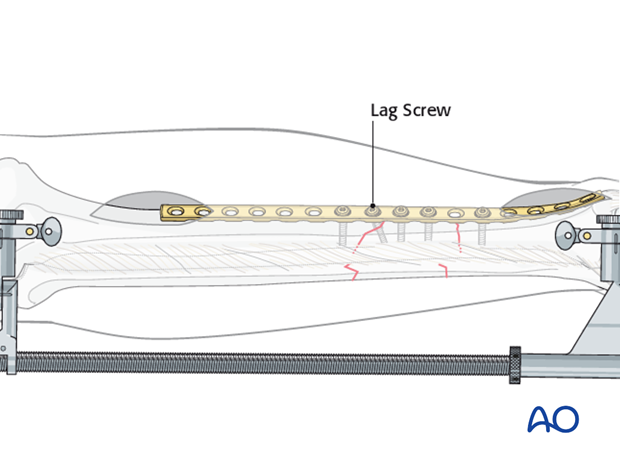
Insertion of remaining screws
Place the remaining screws spreading the fixation. Exchange long screws for those of the proper length.
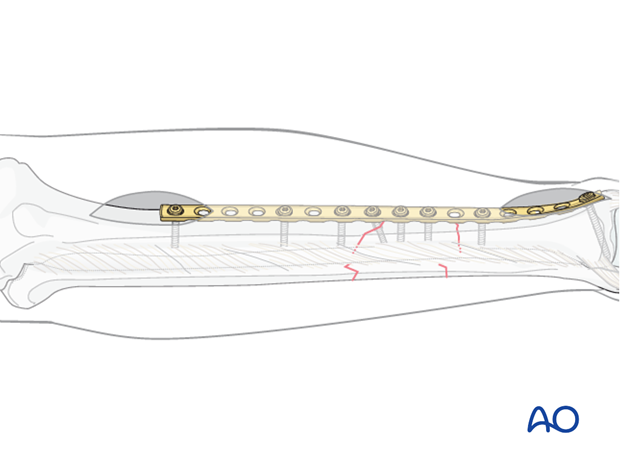
Alternative fixation methods
Multiple techniques are possible depending upon fracture location and obliquity. This figure illustrates the use of dynamic compression (eccentric screw placement in dynamic compression plate holes) to stabilize both fractures.
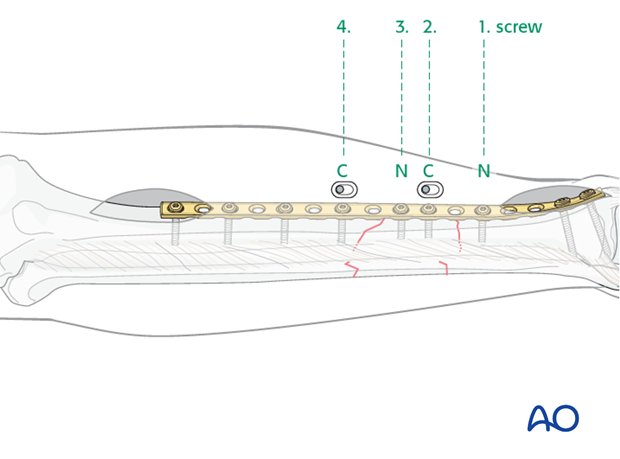
6. Postoperative care
Perioperative antibiotics may be discontinued before 24-48 hours.
After surgery, the patient’s leg should be slightly elevated, with the leg placed on a pillow, 4 cm above the level of the heart.
Attention is given to:
- Pain control
- Mobilization without early weight bearing
- Leg elevation when not walking
- Thromboembolic prophylaxis
- Early recognition of complications

Soft-tissue protection
A brief period of splintage may be beneficial for protection of the soft tissues, but should last no longer than 1–2 weeks. Thereafter, mobilization of the ankle and subtalar joints should be encouraged.
Mobilization
Active and assisted motion of all joints (hip, knee, ankle, toes) may begin as soon as the patient is comfortable. Attempt to preserve passive dorsiflexion range of motion.
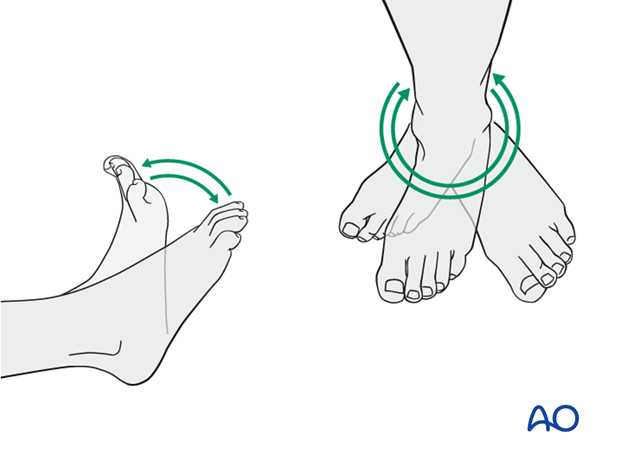
Weight bearing
Limited weight-bearing (15 kg maximum), with crutches, may begin as tolerated, but full weight bearing should be avoided until fracture healing is more advanced (10-12 weeks).
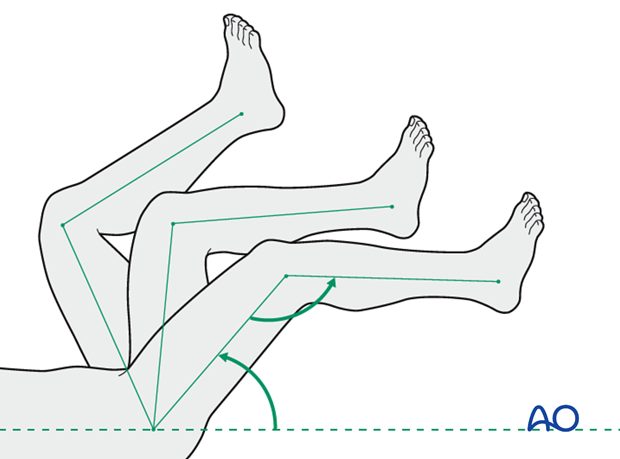
Follow up
Follow-up is recommended after 2, 6 and 12 weeks, and every 6-12 weeks thereafter until radiographic healing and function are established. Depending on the consolidation, weight bearing can be increased after 6-8 weeks with full weight bearing when the fracture has healed by x-ray.
Implant removal
Implant removal may be necessary in cases of soft-tissue irritation by the implants. The best time for implant removal is after complete bone remodeling, usually at least 24 months after surgery. This is to reduce the risk of refracture.













